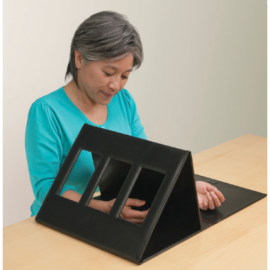What is Mirror Therapy?
In recent years, mirror therapy has gained significant attention as a potential treatment for various neurological conditions and chronic pain management. This innovative therapy utilizes mirrors to create an illusion that tricks the brain into perceiving a reflection of a limb as the affected limb, leading to a range of therapeutic benefits. From stroke rehabilitation to phantom limb pain, mirror therapy has shown promise in improving motor function and reducing pain perception. Let's delve deeper into the concept of mirror therapy and its applications in healthcare.
Mirror therapy involves the use of a mirror to create a visual illusion that makes it appear as if the affected limb is moving normally. It was first introduced in the 1990s by Dr. Vilayanur S. Ramachandran, a neuroscientist, as a treatment for phantom limb pain. Since then, it has been further developed and adopted for a broader range of conditions.
The underlying principle of mirror therapy lies in the concept of neuroplasticity—the brain's ability to reorganize itself and form new neural connections. By providing visual feedback through the mirror, mirror therapy aims to retrain the brain and encourage the recovery of motor function in the affected limb.
During a mirror therapy session, the patient positions the mirror in such a way that it reflects the unaffected limb, while the affected limb remains hidden behind the mirror. This arrangement creates the illusion that the reflected limb is the affected limb. The patient then performs a series of exercises with the unaffected limb, observing the reflection in the mirror. As a result, the brain perceives the reflected limb as moving and functioning normally.
Mirror therapy has been extensively studied and applied in various clinical settings. It has proven particularly beneficial for individuals who have experienced a stroke. By engaging in mirror therapy, stroke survivors can enhance their motor recovery by stimulating the brain's neuroplasticity. The visual feedback from the mirror helps reestablish the connection between the brain and the affected limb, leading to improved movement and coordination.
Another area where mirror therapy has shown promising results is in the management of phantom limb pain. Phantom limb pain refers to the sensation of pain in a limb that no longer exists. By using the mirror to create the illusion of the missing limb, mirror therapy helps alleviate the pain by providing visual input that contradicts the brain's perception of the limb's presence.
Additionally, mirror therapy has been explored in the rehabilitation of conditions such as complex regional pain syndrome (CRPS), where it can help reduce pain and improve functional recovery. It has also been used in the treatment of conditions like cerebral palsy, multiple sclerosis, and Parkinson's disease, although further research is needed to determine its efficacy in these contexts.
One of the significant advantages of mirror therapy is its non-invasive nature and absence of side effects, making it a relatively safe treatment option. It can be easily incorporated into rehabilitation programs and performed at home under the guidance of healthcare professionals. Furthermore, mirror therapy is often cost-effective compared to other interventions, offering a viable alternative for patients seeking innovative therapies.
Despite the promising outcomes and growing body of evidence supporting the use of mirror therapy, it is important to note that it may not be suitable for everyone. Individual factors, such as cognitive ability and motivation, can influence the effectiveness of the therapy. Therefore, a comprehensive assessment by healthcare professionals is crucial to determine the appropriateness and potential benefits of mirror therapy for each patient.
In conclusion, mirror therapy is a fascinating and promising treatment approach that utilizes visual illusions to promote motor recovery and pain reduction. Its applications in stroke rehabilitation, phantom limb pain, and other neurological conditions have shown positive outcomes. As researchers continue to explore its potential and refine the protocols, mirror therapy holds the potential to transform the way we approach rehabilitation and chronic pain management, providing new hope for individuals seeking improved function and quality of life.


